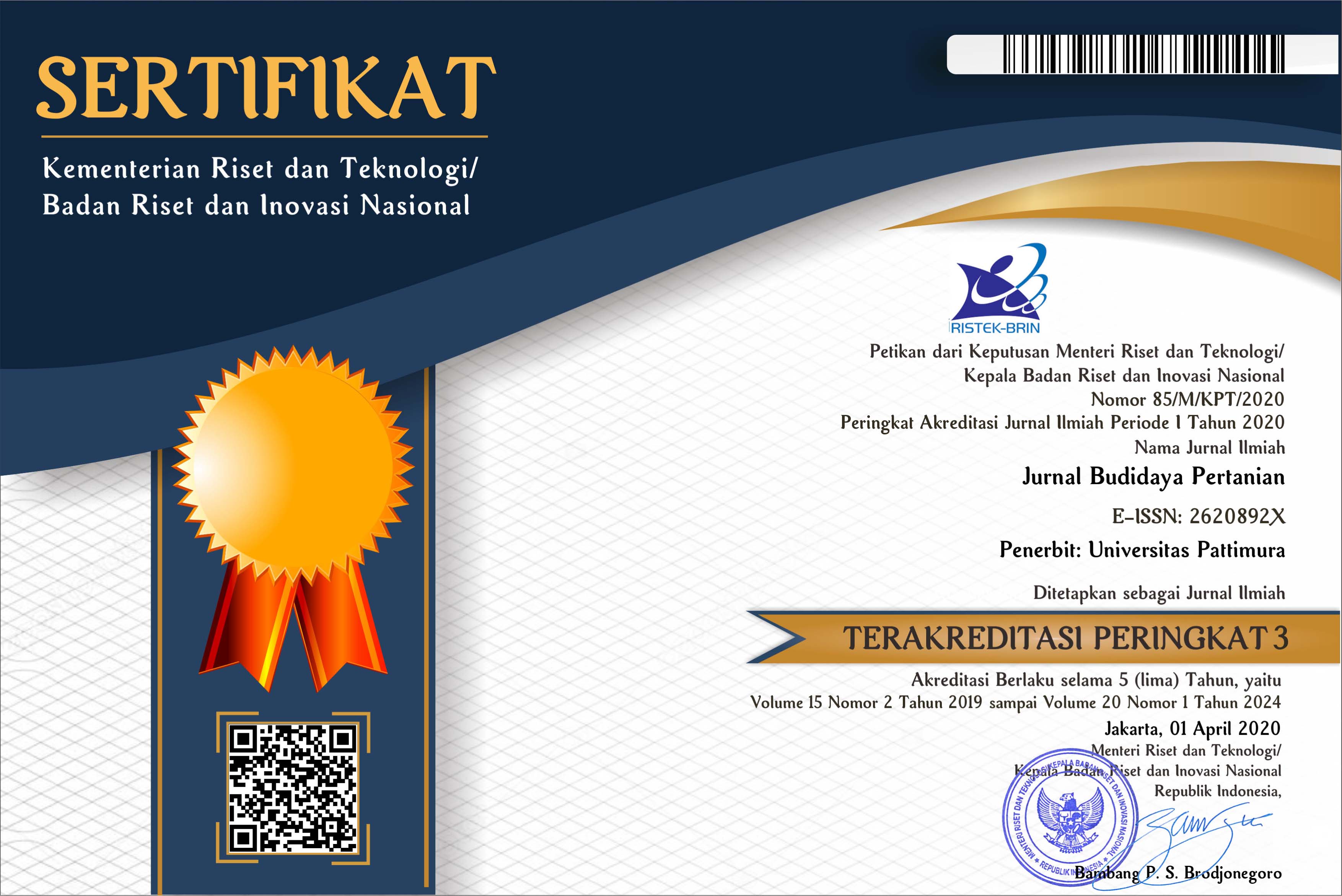Aplikasi Pupuk Cair dari Limbah Organik dan Nano Nutrien pada Berbagai Varietas Ubi Kayu (Manihot esculenta Crantz)
Application of Liquid Fertilizer in Various Types Cassava Varieties (Manihot esculenta Crantz)
Abstract
Increasing cassava production can be achieved among others by giving various forms of fertilizer to provide the nutrients needed by plants. This research aimed to determine the effect of applying liquid fertilizer from organic waste and nano nutrients on the growth of various cassava varieties. The research was carried out from March to November 2023, at the experimental field of the Faculty of Agriculture, Tidar University, in Sidorejo Village, Bandongan District, Magelang Regency. The experimental research was carried out using a factorial design in a Split Plot experiment with 3 replications as blocks. The first factor was the types of varieties consisting of Sticky Rice, Butter, Klenteng, and Rengganis. The second factor as a subplot is liquid fertilizer in the form of slaughterhouse waste and nano nutrients. The data were analyzed using analysis of variance and followed by a Least Significant Difference test at the a = 0.01 and 0.05 levels, as well as the orthogonal test. The results showed that the type of variety used did not have a significant effect on the variables of plant height increase, branch number, branch height, leaf number, root number, root fresh weight, and photosynthesis rate. Rengganis variety had a very significant effect on leaf chlorophyll levels. The application of liquid organic fertilizer, both from slaughterhouse waste and nano nutrients, did not have a significant effect on the variables of plant height increase, branch number, branch height, leaf number and root fresh weight. Liquid fertilizer from slaughterhouse waste hah a significant effect on root number, whereas nano nutrient fertilizer had a significant effect on the rate of photosynthesis and has a very significant effect on leaf chlorophyll content. There was an interaction between varieties and the provision of liquid fertilizer on leaf chlorophyll content.
Downloads
References
Agung, S.W. (2013). Pengaruh Pupuk Magnesium (Mg) Terhadap Produksi dan Serapan Hara N, P, K, Ca, Mg Tanaman Kacang Hijau di Latosol Darmaga. Skripsi. Fakultas Pertanian, IPB. Bogor.
Ariningsih, E. (2016). Prospek penerapan teknologi nano dalam pertanian dan pengolahan pangan di Indonesia. Forum Penelitian Agro Ekonomi, 34(1), 1-20. DOI:10.21082/fae.v34n1.2016.1-20
Dharmadewi., A.A.I.M. (2020). Analisis kandungan klorofil pada beberapa jenis sayuran hijau sebagai alternatif bahan dasar food suplement. Jurnal Edukasi Matematika dan Sains, 9(2), 171-176. https://doi.org/10.5281/zenodo.4299383
FAO. (2013). FAO Statistical Yearbook 2013. In Crop Production Statistic, Volume 1. Food and Agriculture Organization : Rome.
Firmansyah, I., Syakir & Lukman, L. (2017). Pengaruh kombinasi dosis pupuk N, P, dan K terhadap pertumbuhan dan hasil tanaman terung (Solanum melongena L.). Jurnal Hortikultura, 27(1), 69-78. https:// doi.org/10.21082/jhort.v27n1.2017.p69-78
Gogahu, Y., Nio, S.A., & Siahaan, P. (2016). Konsentrasi klorofil pada beberapa varietas tanaman puring (Codiaeum varigatum L.). Jurnal MIPA UNSRAT, 5(2), 76-80. https://doi.org/10.35799/jm.5.2.2016.12964
Kementrian Pertanian. (2020). Peningkatan Produktivitas Ubi Kayu. Kementrian Pertanian. Jakarta.
Licung., Sasli, I., & Darussalam. (2020). Respon pertumbuhan dan hasil terung ungu terhadap pemberian pupuk organik cair (POC) rumen sapi pada tanah aluvial. Jurnal Universitas Tanjungpura, 1(8), 1-8. https://dx.doi.org/10.26418/jspe.v10i2.45042
Nur’aeni, E., Kartika, A.M. & Susiyanti. (2020). Pengaruh pemberian beberapa konsentrasi pupuk majemuk berteknologi nano terhadap pertumbuhan dan hasil tiga varietas tanaman bawang merah (Allium ascalonicum L.). Jurnal Agroekotek, 12(1), 110-120. https://dx.doi.org/10.33512/jur.agroekotetek.v12i1.8783
Oktiawan, W., Suryanto, A. & Nugroho, A. (2015). Strategi produksi pupuk organik cair komersial dari limbah rumah potong hewan (RPH) Semarang. Jurnal Presipitasi, 12(2), 89-94.
Rahmah, A., Izzati, M., Parman, S. & Biologi, J. (2014). Pengaruh pupuk organik cair berbahan dasar limbah sawi putih (Brassica chinensis L.) terhadap pertumbuhan tanaman jagung manis (Zea mays L. var. Saccharata). Jurnal Buletin Anatomi dan Fisiologi, 12(1), 65-71. https://doi.org/10.14710/baf.v22i1.7810
Salama, H.M. (2012). Effects of silver nanoparticles in some crop plants, common bean (Phaseolus vulgaris L.) and corn (Zea mays L.). International Research Journal of Biotechnology, 3(10), 190-197.
Saleh, N., Tayfiq, A., Widodo, Y., Sundari, T., Gusyana, D., Rajagukguk, R.P. & Suseno, S.A. (2016). Pedoman Budidaya Ubi Kayu di Indonesia. IAARD Press. Jakarta.
Siswanti, L., Ardie, S.W. & Khumaida, N. (2019). Pertumbuhan dan perkembangan ubi kayu ganotipe lokal manggu pada panjang stek batang yang berbeda. Jurnal Agronomi Indonesia, 47(3), 262-267. https://doi.org/10.24831/jai.v47i3.26610
Solikhah, R., Purwantoyo, E. & Rudyatmi, E. (2019). Aktivitas antioksidan dan kadar klorofil kultivar singkong di daerah Wonosobo. Life Science, 8(1), 86-95. https://doi.org/10.15294/lifesci.v8i1.30001
Suhardjadinata, & Pangesti, H. D. (2016). Proses produksi pupuk organik limbah rumah potong hewan dan sampah organik. Jurnal Siliwangi, 2(2), 101-107.
Yama, D.I. & Kartiko, H. (2020). Pertumbuhan dan kandungan klorofil pakcoy (Brassica rappa L.) pada beberapa konsentrasi AB Mix dengan sistem Wick. Jurnal Teknologi, 12(1), 21-30. https://doi.org/10.24853/jurtek.12.1.21-30
Copyright (c) 2023 Siti N Iftitah, Yulia E Susilowati, Historiawati Historiawati, Murti Astiningrum, Woro A Novita, Alfina R Damayanti

This work is licensed under a Creative Commons Attribution-ShareAlike 4.0 International License.

 Accreditation is valid for 5 years, starting from Volume 15 Issues 2 December 2019 up to Volume 20 Issue 1 June 2024.
Accreditation is valid for 5 years, starting from Volume 15 Issues 2 December 2019 up to Volume 20 Issue 1 June 2024.






